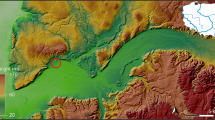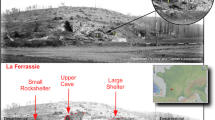Abstract
Since 2005, excavations at Mare aux Songes, Mauritius, have revealed the presence of a very rich, ∼4,200-year-old fossil bone bed including dodo (Raphus cucullatus) bones and bone fragments. The recently excavated dodo assemblage comprises at least 17 individuals and is characterised by the presence of small and fragile skeletal elements, a dominance of leg elements and an absence of juveniles. The hydrology of the area suggests that dodos, like many other species, were probably lured to Mare aux Songes by the presence of freshwater during times of drought. The most likely scenario for the origin of the fossil deposit is that animals became trapped in the sediment in repeated miring events, which would favour the conservation of hindlimbs. Such a scenario is fully in accordance with the taphonomic characteristics of the bone assemblage.






Similar content being viewed by others
References
Angst D, Buffetaut E (2010) Un dodo en Normandie. Bull S.E.S.N.E. 9–16
Angst D, Buffetaut E, Abourachid A (2011a) The end of the fat dodo? A new mass estimate for Raphus cucullatus. Naturwissenschaften 98:233–236
Angst D, Buffetaut E, Abourachid A (2011b) In defense of slim dodo: a reply to Louchart and Mourer-Chauviré. Naturwissenschaften 98:359–360
Behrensmeyer AK (1978) Taphonomic and ecologic information from bone weathering. Paleobiology 4:150–162
Behrensmeyer AK, Gordon KD, Yanagi GT (1989) Non-human bone modification in Miocene fossils from Pakistan. In: Bonnichsen R, Sorg MH (eds) Bone modification (Proceedings of First International Conference on Bone Modification). Center for the Study of the First Americans, Orono, pp 99–120
Behrensmeyer AK, Stayton CT, Chapman RE (2003) Taphonomy and ecology of modern avifaunal remains from Amboseli Park, Kenya. Paleobiology 29:52–70
Braun A, Pfeiffer T (2002) Cyanobacterial blooms as the cause of a Pleistocene large mammal assemblage. Paleobiology 28:139–154
Carié MP (1930) Le Leguatia Gigantea Schlegel (Rallidé) a-t-il existé? Bull Mus Nat d’Hist Nat 2:205–213
Cheke AS, Hume JP (2008) Lost land of the dodo: an ecological history of Mauritius, Reunion and Rodrigues. A & C Black, London
Clark G (1866) Account of the late discovery of dodo remains in the island of Mauritius. Ibis 2:141–146
Cowles GS (1987) The fossil record. In: Diamond AW (ed) Studies of Mascarene Island birds. Cambridge University Press, Cambridge
Ericson PGP (1987) Interpretations of archaeological bird remains: a taphonomic approach. J Arch Sci 14:65–75
Gasse F (2000) Hydrological changes in the African tropics since the last glacial maximum. Quat Sci Rev 19:189–211
Günther ACLG (1875) The gigantic land Tortoises of the Mascarene and Galapagos Islands. II. Nature 29:259–261
Hoffstetter R (1945) Sur les Scincidae fossiles. II. Formes subfossiles de l’Ile Maurice. Bull Mus Natl d’Hist Nat Paris 17:80–86
Hoffstetter R (1946a) Sur les Gekkonidae fossiles. Bull Mus Natl Nat Paris 2e Sér 18:195–203
Hoffstetter R (1946b) Les Typhlopidae fossiles. Bull Mus Natl Nat Paris 2e Sér 18:309–315
Holdaway RN, Worthy TH (1997) A reappraisal of the late Quaternary fossil vertebrates of Pyramid Valley Swamp, North Canterbury, New Zealand. N Z J Zool 24:69–121
Hume JP (2005) Contrasting taphofacies in ocean island settings: the fossil record of Mascarene vertebrates. Proceedings of the International Symposium “Insular Vertebrate Evolution: the Paleontological Approach”. Mon Soc d’Hist Nat Bal 12:129–144
Hume JP, Martill DM, Dewdney C (2004) Dutch diaries and the demise of the dodo. Nature 492:622
Hume JP, Cheke AS, McOran-Campbell A (2009) How Owen ‘stole’ the Dodo: academic rivalry deposit in nineteenth century Mauritius. Hist Biol 21:1–18
Johnson P, Gerbeaux P (2004) Wetland types in New Zealand. Department of Conservation, Wellington
Louchart A, Mourer-Chauviré C (2011) The dodo was not so slim: leg dimensions and scaling to body mass. Naturwissenschaften 98:357–358
Marchant RA, Hooghiemstra H (2004) Rapid environmental change in tropical Africa and Latin America about 4000 years before present: a review. Earth Sci Rev 66:217–260
Newton E, Gadow H (1893) On additional bones of the dodo and other extinct birds of Mauritius obtained by Mr. Theodore Sauzier. Trans Zool Soc Lond XIII:281–302
Rijsdijk KF, Hume JP, Bunnik F, Florens FBV, Baider C, Shapiro B, van der Plicht J, Janoo A, Griffiths O, van den Hoek Ostende LW, Cremer H, Vernimmen T, de Louw PGB, Bholah A, Saumtally S, Porch N, Haile J, Buckley M, Collins M, Gittenberger E (2009) Mid-Holocene vertebrate bone concentration-Lagerstätte on oceanic island Mauritius provides a window into the ecosystem of the dodo (Raphus cucullatus). Quat Sci Rev 28:14–24
Rijsdijk KF, Zinke J, de Louw PGB, Hume JP, van der Plicht J, Hooghiemstra H, Meijer HJM, Vonhof HB, Porch N, Florens FBV, Baider C, van Geel B, Brinkkemper J, Vernimmen T, Janoo A (2011) Mid-Holocene (4200 kyr BP) mass mortalities in Mauritius (Mascarenes): insular vertebrates resilient to climatic extremes but vulnerable to human impact. Holocene. doi:10.1177/0959683611405236
Turvey ST, Holdaway RN (2005) Postnatal ontogeny, population structure, and extinction of the giant moa Dinornis. J Morph 265:70–86
Wood JR, Worthy TH, Rawlence NJ, Jones SM, Read SE (2008) A deposition mechanism for Holocene miring bone deposits, South Island, New Zealand. J Taph 6:1–20
Worthy TH (1998) The Quaternary fossil avifauna of Southland, South Island, New Zealand. J R Soc N Z 28:537–589
Worthy TH (2000) Two late-Glacial avifaunas from eastern North Island, New Zealand-Te Aute Swamp and Wheturau Quarry. J R Soc N Z 30:1–26
Acknowledgements
We are very grateful to C. Foo Kune, former CEO of Mon Trésor Mon Désert Sugar Estate (now Omnicane), and his staff for their hospitality and invaluable support in the field. The excavation would not have been possible without the technical supervision by R. Floore. We thank A. Janoo (National Heritage Fund), C. Baider, F.B.V. Florens, A. Grihault, J. de Vos and J. Brinkkemper for their support in the field and valuable discussions regarding the extinct and extant Mauritian ecosystem. I. Prins provided invaluable logistic support. Fieldwork and research was funded by Omnicane, TNO—the Geological Survey of the Netherland, the Treub Foundation for Research in the Tropics, World Wildlife Fund—The Netherlands, Deltares, Mauritius Museums Council, Hollandia Archaeology, Taylor Smith Group (Mauritius), Air Mauritius, Mauritius Sugar Industry Research Institute and the Netherlands Centre for Biodiversity Naturalis. The funders had no role in study design, data collection and analysis, decision to publish or preparation of the manuscript. We thank S. Olson for insightful comments on an earlier version of the manuscript, and A. Cheke for help on correct citation details. Four anonymous reviewers provided their constructive input.
Author information
Authors and Affiliations
Corresponding author
Additional information
Communicated by: Sven Thatje
Electronic supplementary material
Below is the link to the electronic supplementary material.
ESM 1
(PDF 88 kb)
Rights and permissions
About this article
Cite this article
Meijer, H.J.M., Gill, A., de Louw, P.G.B. et al. Dodo remains from an in situ context from Mare aux Songes, Mauritius. Naturwissenschaften 99, 177–184 (2012). https://doi.org/10.1007/s00114-012-0882-8
Received:
Revised:
Accepted:
Published:
Issue Date:
DOI: https://doi.org/10.1007/s00114-012-0882-8




